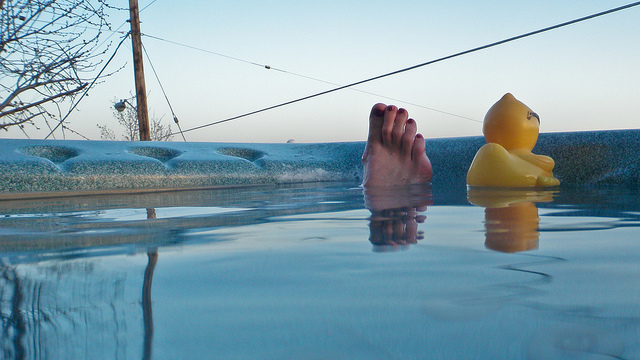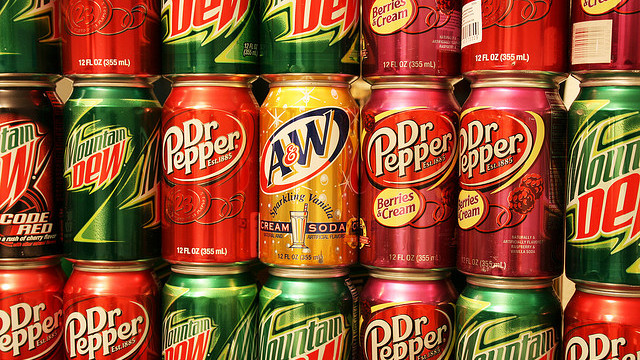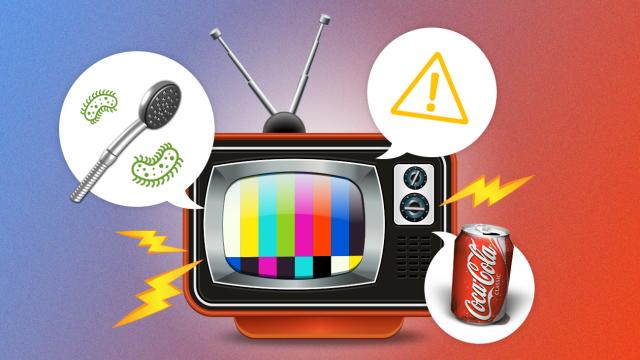The media loves blowing relatively minor issues up into huge stories. Whether it’s something in your refrigerator that’s out to kill you or a the filthiness of a jacuzzi, most of this stuff is meant to grab your attention long enough to scare you without actually explaining anything. But some of this stuff is worth paying attention to. Here are a few examples.
Title photo by Tina Mailhot-Roberge. Photos by Michael, redspotted, and Alexander Kaiser.
The Story: Public Hot Tubs And Showers Are Rife With Disease

It seems like once or twice a year, the news decides to remind us all that any type of public washing area is disgusting. These stories typically come about in overblown, hyperbole-filled rants about diseases like Legionnaires, or at the very least are accompanied by gross out stories of Athlete’s foot.
Unfortunately, most of these warnings are absolutely true. It’s pretty easy to avoid problems though. Let’s start with hot tubs: Bacteria loves to hang out in hot tubs because the water is the perfect temperature for them. Not too hot, and not too cold (as a pool would be). The most common germs you’ll come into contact with in a hot tub are Pseudomonas aeruginosa (which causes hot tub rash) and the aforementioned Legionella. According to the CDC, several outbreaks of both were linked back to hot tubs.
Sounds gross, right? It is. But most public hot tubs are monitored regularly and you should see tub cleaning information posted near the tub. According to The Wall Street Journal, here’s what to look for:
If they use chlorine, you should look for a value of between 2 and 4 parts per million, and if they are using bromine, which is a similar disinfectant but lasts longer in hot temperatures, you’d look for a value between 4 and 6 parts per million…
When the jets are off, hot-tub water should be clear, not murky. “If you can’t see the bottom, that is not a good sign,” says [CDC epidemiologist Jonathan] Yoder. Slimy edges indicate not enough disinfectant, while a strong odor might suggest the chemical is reacting with other substances. “Don’t rely on a strong chemical smell to indicate that a hot tub is well-maintained,” he says.
As for public showers, things get a bit grosser. Two of the more common problems you can run into by showering in a public shower are fungal infections like athlete’s foot or ringworm, or warts. You won’t find hard statistics about how often they’re found in public showers, but we know enough about how they spread to assume it’s one of the most common breeding grounds for both. Thankfully, prevention is the same in both cases. Wear sandals, dry yourself off quickly (with your own towel — don’t borrow one from someone else), and make sure any open wounds are covered with a bandage.
Of course, it’s also worth noting that in both hot tubs and showers, you’re in a public space, so proper hand washing is essential.
The Story: Instant Noodles Can Easily Cause Serious Burns

A few years ago, US broadcaster NPR took a look at a study about how instant noodle containers send children to the hospital daily with burns. It turns out that’s true, but it’s not for the reason you’d think.
When you put a Styrofoam cup filled with liquid in the microwave, it’s bound to get hot and obviously you should be careful with it. That’s common sense. However, the problem with many instant noodles is the packaging. NPR explains:
To test it, the study authors went to the grocery store and bought 11 brands of soup manufactured all over the world and calculated the angle at which the soup tipped over and spilled. Not surprisingly, tall cups with a narrow bottom tip over about three times more easily than short, squat containers with a wide, stable base…
So, before you hand over that cup of instant noodles — or any other hot liquid — to your kid, make sure it’s in a cup that isn’t prone to tipping over. Or at the very least, put it in a real bowl.
The Story: Credit Card Thieves Target Everything That Accepts Credit Cards

As technology moves forward, it seems like we hear more and more about credit card skimmers. Reports put them on ATMs, petrol pumps, and even in McDonald’s. These small devices rest on top of places where you swipe your credit card and they steal your information as you do it.
The fact is, these ATM skimmers do seem to be on the rise in some locations. But there’s good news too. First off, you can often spot them by just looking at them. NPR suggests checking for cameras, pulling on the card slot, and wiggling the keypad. A recent Reddit post shows how a machine might look and suggests that if two machines are next to each other, it’s worth seeing if they’re identical.
Beyond that, it’s mostly about avoiding the problem entirely. Shield your PIN with your hand, use indoor ATMSs where possible, and don’t record your PIN anywhere near your card.
The Story: The Latest Hack Will Devastate The Internet

It seems like every week we hear about a new hack or an egregious violation of privacy from a social network. Credit cards get hacked frequently, and it sometimes seems none of your information is safe anywhere, ever. Worse, flaws like Heartbleed and Shellshock affect everyone regardless of how safe they think they’re being online.
This is all true, but before you build a bunker, leave your bank, and remove yourself from the internet, it’s important to think about what’s really going on. With security, it’s really a combination of both a precautionary and reactive approach. As far as prevention is concerned, the best thing you can do is make sure HTTPS is enabled anywhere you’re shopping online, and that you’re only shopping at reputable online sellers.
The same goes for your data. Use a password manager and be sure to change any passwords if a service you use is hacked. With something like Heartbleed, it’s important to keep an eye on any updates as they’re released. Likewise, make sure your operating system and software is up to date with the most recent security precautions.
The only information you really need to keep an eye on in a news story is “who was hacked?” Did you shop there? Do you have an account there? Then change your password. The amount of people involved, what the hackers got, and whether or not they got your account does not matter. Just change your password and keep an eye on your bank accounts.
Story: Soft Drink Is Single-Handedly Ruining Your Health

In recent years, carbonated soft drink has been a prime target for health research. It’s long been known that the high sugar content of soft drink wreaks havoc on your teeth, but in recent years we’ve seen all kinds of studies that show other effects of soft drink on general health.
Let’s start by going through some of the more significant studies. In a study published in 2012 of over 42,000 men, researchers found a correlation between soda consumption and an increased risk of heart attack. In a massive, 22 year long study of 80,000 women, researchers found a can a day of a sugary drink can lead to a 75% increase in the risk of gout in women. More recently, researchers claimed soft drink may age you as much as smoking. In a meta analysis of studies from Harvard, researchers found support that linked soft drink and obesity.
However, another analysis of those same studies found them inconclusive while another study found similar results. Much of the veverage research has been questioned for biases related to who’s funding it, with many of the beverage companies providing the funding of the research. Basically, it’s a lot of correlation between soft drink consumption and health issues, but we’re not sure if (or what) ingredients are the cause.
In short, the research is a confusing mess. We know the effects of sugar, calories, and fat on our bodies. Soft drink contains sugar, which contains calories, and the more you take in without expending energy, the more weight you’ll gain. However, the real question with soft drink is more about how it makes you feel. Soft drink doesn’t make you feel full, but you’re still ingesting calories. Even this is up for debate though. The Awl explains that researchers provide evidence for and against soft drink as empty calories.
It’s all a bit confusing, but Slate breaks down what we really know pretty simply:
Can targeted interventions to reduce soft-drink consumption really prevent weight gain? We’ve seen only a few randomised, controlled trials, and their results are not unambiguous. Would drinking less soda make everyone healthier, or just some people? The data suggest that little kids are better at regulating their liquid-calorie intake than are adolescents, and some adults may be more vulnerable to soft drinks than others.
Which is to say, if you’re worried about tooth decay, skip soft drinks. If you’re worried about obesity, at least cut back on soft drink consumption. If you’re worried that drinking soft drink kills you as quickly as cigarettes, you can probably rest easy for now. Thankfully, plenty of awesome alternatives exist.
How To Root Out The Truth In A News Article

The above examples are just a small sample of the things we’re supposed to be scared of. We know that media outlets love to invoke fear with news stories and sometimes it’s really easy to get caught up in it to the point where you can’t tell what’s true. This ends up just making you paranoid and scared to do anything in public. Here are a few ways to root out whether that paranoia is worth paying attention to or ignoring:
- Take a close look at the studies involved and the sources: We’ve walked you through conducting scientific research online before and the same holds true with news. Look at the sources to see if they’re reputable, look at how many people were involved in a study, and investigate who conducted the study. Even if research comes from a reputable source like Harvard, it might be such a small sample size that it doesn’t really mean anything. So, pay attention and think about what’s really proven.
- Ignore headlines: Often, a headline doesn’t correspond to the text beneath it, so actually read the article before you decide to put on your tinfoil cap. In some cases, like health issues, you might find that some crazy headline doesn’t actually correspond to you or your life at all. Likewise, with tech, security or privacy issues, you might find that you just don’t care or use the services in question.
- Be wary of emotional images: With something like ebola, the media likes to play up the story with images of doctors in crazy suits and patients with masks on. These images tell you that you should be scared, but not much else. The fact is, most doctors dealing with anything contagious are dressed like that, there’s nothing different or special about whatever they’re warning you about. The same goes for every story about soft drink. They’re frequently accompanied by an overweight person slurping a drink the size of Mexico. Those images have more impact on how you read an article than you might think, so make a note of them and try to ignore them when you can.
- Find other sources: Finally, if you read an article that terrifies you, find another source to see what they say. The fact is, you can spin the news in a lot of ways, so reading a few different sources is often an easy way to figure out if something’s legitimately scary or not.
Of course, we’ve only touched the surface of these types of media scares. Every week something new pops up, but you should now have the toolkit to root out what’s worth paying attention to and what to ignore.

Comments
7 responses to “Five Fear-Mongering Stories That Are True (But Overblown)”
Before you hand over a steaming hot cup of instant noodles to your child. How about considering cooking something more nutritious. Hell, instant oats with a couple of slices of banana and a splash of honey takes about the same time…
How about considering letting people make their own decisions?
Also, I don’t think ramen and oats are exactly fighting over the same mealtime.
So OkensaiO’s post somehow eliminated your ability to make your own decision?!
The Jedi mind tricks are strong here…
If you considered instant cup noodles as a meal substitute for a kid, there are bigger issues here…I was referring to someone using instant noodles as a quick snack to which instant oats maybe a better substitute (so will milk and cookies in fact…)
People can make their own decisions. More information never hurt anyone. A fact this very article is clearly illustrating.
> When you put a Styrofoam cup filled with liquid in the microwave, it’s bound to get hot and obviously you should be careful with it.
I… I’ve been doing it wrong all my life? I boil a pot of water, then put that in the styrofoam cup.
And you’re the sole reason for thousands of children getting burned. I HOPE YOU’RE HAPPY!
But seriously, I do the boiling water thing too. That’s what the instructions say, though some might microwave if they’re short on time.
Did anyone else find it amusing to read this sentence in a Giz article?